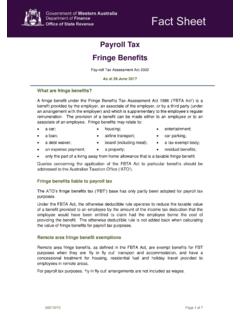Transcription of More prisons are not the answer to reducing crime
1 More prisons are not the answer to reducing crimePrisons are meant to protect the community and reha bilitate offenders. Yet, evidence shows that prison often fails to rehabilitate people and may increase the risk of this, we continue to lock up more and more people, mostly from disadvantaged backgrounds, at huge social and financial cost to the community. Putting more people in prison diverts resources from vital social infra structure and cost effective initiatives which have been shown to successfully address the causes of crime . There are better and more cost effective ways of reducing crime than prison population is rapidly increasingOver the past decade, Victoria s prison population has increased dramatically, rising 44%. On 30 June 2010 there were 4,537 prisoners in Victoria. While the large majority of prisoners are men, the rate of increase for women pris oners has been higher than the rate for male sentencing is driving rises in our prison populationThe Victorian Ombudsman has stated that the increased prison population in Victoria has been attributed to changes in sentencing practice and a generally more punitive approach reflecting strong community pressure for law and order.
2 2 This is supported by research from the Sentencing Advisory Council which found that the average prison sentence length increased around 18% between 2000/01 and 2005 A 2010 Department of Justice document reported that key drivers which have led to significant prisoner population growth include tougher and longer sentences .4 Other research suggests that the deinstitutionalisation of psychiatric facilities has resulted in people with serious mental illness moving from psychiatric beds to prison growth is set to accelerate over the next decadeThe rise in Victoria s prison population is set to continue and accelerate over the next decade. Cabinet documents obtained by The Age newspaper show that in 2010, under the sentencing policies of the former Labor Government, the Department of Justice predicted that prison numbers would increase another 45% to 6620 in Liberal National Government has promised to introduce a range of harsher sentencing policies which will accelerate this increase.
3 A 2011 Department of Justice report states projections indicate that the prison popula tion will continue to grow into the future. Sentencing reform such as the abolition of home detention and sus pended sentences, as well as the proposed mandatory min imum sentencing for certain serious offences is expected to be the main driver of growth in prison bed demand. 7 So, harsher sentencing will be the main driver of prison growth, not crime rates, which are s prisons are already full and the Adult Parole Board has noted emerging problems of overcrowding .9We are spending more than ever on prisons and this will continue to risePrison construction is extremely expensive. In the 2010/11 Victorian State Budget, the Victorian Government announced $126 million spending to build 244 additio nal prison beds a cost of over $500,000 per prison Housing someone in prison is also extremely expensive. Council of Australian Government figures show that the average real net operating expenditure per prisoner per day in 2009 10 was $ , or close to $90,000 per year.
4 In contrast, the average real net operating expenditure per community corrections offender per day was $ or less than $7,000 per Government annual spending on prisons (excluding community corrections) has increased 151% over the past decade to $593 million in 2011 Spend ing is set to accelerate over the next decade to cater for the rapidly expanding prison population. Based on 2010 This factsheet is for information and discussion purposes only. It does not necessarily represent the views of organisations involved in the Smart Justice factsheet has been supported by grants from the Victoria Law Foundation and the Reichstein Foundation Smart action for a safer community estimates of prison growth over the next decade, addi tional prison construction will cost over $1 billion and operating costs will be close to $200 million a year on top of current are typically from highly disadvantaged backgroundsThe people we are locking up in prison have typically experienced high levels of disadvantage in their lives.
5 For example: only of male and 18% of female Victorian prisoners completed secondary, trade or tertiary education;14 69% of male and 49% of female Victorian prisoners were unemployed when they were imprisoned;15 87% of female prisoners in Victoria were victims of sexual, physical or emotional abuse, with the majority being victims of multiple forms of abuse;16 and Indigenous Australians are 14 times more likely to be in report Growing Victoria Together found that approxi mately 50% of the Victorian prison population had two or more characteristics of serious disadvantage which included unemployment, intellectual disability, drug or alcohol issues, homelessness and prior admission to a psychiatric often fails to stop reoffending56% of Australian prisoners have been in prison Victoria is comparatively doing better than other states in preventing reoffending. The rate of Victorian prisoners returning to prison within 2 years has dropped every year since 2001/02.
6 Still, 49% of Victorian prisoners have been in prison prison sentences don t deter crime and can increase reoffendingLonger prison terms are sometimes supported on the basis that they deter crime by sending a message to offenders. Yet, research suggests increasing prison terms doesn t deter a recent report on deterrence, the Victorian Sentencing Advisory Council concluded that the research suggests imprisonment has a negative but generally insignificant effect upon the crime rate, representing a small positive deterrent effect however increases in the severity of no corresponding increased deterrent effect upon offending. 21 In other words, the general threat of imprisonment has a very small deterrent effect but increasing prison terms doesn t deter more terms are also sometimes supported on the basis that exposing someone to tough punishment means they won t offend again. However, the Council s report found the available research suggests that imprisonment has either no effect upon reoffending or a criminogenic effect.
7 22 In other words, exposing someone to prison doesn t reduce reoffending and may in fact increase it. Further, harsher prison conditions over the course of a sentence do not generate a greater deterrent effect, and the evidence shows that such conditions may lead to more violent reoffending. 23 Explanations for the failure of imprisonment to deter offenders from reoffending include that imprisonment may create a criminal learning environment, imprison ment may label and stigmatise offenders and impris onment may be an inappropriate way to address the underlying causes of crime . 24 As leading social researcher Tony Vinson has said, imprisonment can reflect and help to sustain limited education, unemployment, poverty, homelessness, and associated social difficulties. 25 prison often exacerbates the problems that cause offending and fails to break the cycle of are better and cheaper ways of reducing crime than prisonPutting someone in prison generally stops them from offending for the period of their imprisonment.
8 However, as a crime control mechanism, prison is blunt, harmful and extremely expensive. Studies suggest that very sub stantial increases in imprisonment will produce only a modest reduction in Worse, as outlined above, there is evidence that prison may increase the likelihood of people reoffending after up more people in prison isn t the way to cre ate a safer society. NSW imprisons people at almost twice the rate of Victoria and yet the crime rate in NSW isn t There are better and more cost effective ways of reducing disadvantage reduces crimeMany different factors influence whether a particular person will commit crimes. Causes of criminal behaviour vary between different people and between different types of crimes. However, there is general consensus that child neglect is one of the strongest factors which increases the risk of involvement in crime . Poverty, unemployment and alcohol abuse are also risk is strong evidence that early intervention pro grams targeting at risk children and youth are cost effec tive ways to reduce There is also research which indicates that reducing disadvantage and increasing income equality will reduce Similarly, there is also evidence that providing stable housing and employ ment opportunities can reduce Ignored, mismanaged, released unprepared, rapidly re-offending and returning to prison .
9 This is all too often the story of the mentally ill offender, repeated and repeated. victorian institute of forensic mental health, Department of Justice, Statistical Profile of the Victorian prison System 2005-06 to 2009-10 (2010).2 Ombudsman Victoria and Office of Police Integrity, Conditions for persons in custody, (2006), Fisher, Victoria s prison Population: 2001 to 2006 , (2007) Sentencing Advisory Council, p Department of Justice Partnerships Victoria Ararat prison Project (2010), 5- White & Whiteford (2006) prisons : mental health institutions of the 21st century? 185(6) Medical Journal of Australia 302, Royce Millar, Super jails to cost billions The Age 11 Jun e Department of Justice Annual Report 2010-11, Victoria Police, crime Statistics 2010/11, 4 and Adult Parole Board Annual Report 2010/11, Minister for Police, Corrections & Emergency Services, State Budget 2010: 1,966 More Frontline Police To Keep Our Community Safe (Media release, 4 May 2010).
10 11 Corrections Statistics FAQs on Victorian State Budget papers show the prison budget (excluding community corrections) for 2011/12 was $593 million compared with $236 million in 2002/03: Estimate based on 2083 extra prisoners over the next decade at $500,000 per additional prison bed construction cost plus $90,000 per prisoner annual operating costs; see Royce Millar, Super jails to cost billions The Age 11 Jun e Department of Justice, Statistical Profile of the Victorian prison System 2005-06 to 2009-10 (2010) p 3715 Department of Justice, Statistical Profile of the Victorian prison System 2005-06 to 2009-10 (2010) p 3816 Johnson (2004) Drugs and crime : A Study of Incarcerated Female Offenders, Australian Institute of Criminology, Australian Bureau of Statistics, Prisoners in Australia 2009, , (2009). For more information see Smart Justice Factsheet Ending overrepresentation of Aboriginal and Torres Strait Islander peoples in the criminal justice Department of Premier and Cabinet, Victorian Government, Growing Victoria Together Progress Report, 2005-2006, (2006), Australian Bureau of Statistics, Prisoners in Australia 2009 (2009), Department of Justice, Statistical Profile of the Victorian prison System 2005-06 to 2009-10 (2010) p Sentencing Advisory Council Does Imprisonment Deter?




